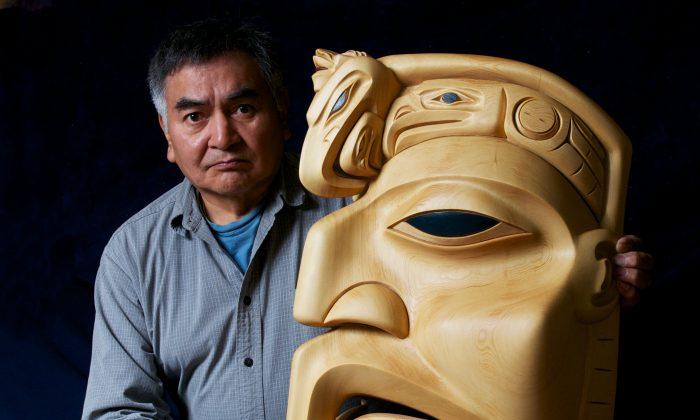You’ve probably seen Dempsey Bob’s artwork before.
The master Northwest Coast carver’s pieces are displayed in prestigious venues across the globe, from Vancouver’s International airport and the Smithsonian in Washington D.C., to museums in Germany, Scotland, and Japan.
From his towering 55 foot totem poles to exquisitely intricate carvings, Bob’s artwork has a common purpose: to honour and preserve his Tahltan and Tlingit culture and art forms.
Bob apprenticed under the late Haida carver Freda Diesing, a driving force behind the Northwest Coast art revival of the 1960s and one of the few female carvers of her time. In 2006, Bob helped found the Freda Diesing School of Northwest Coast Arts, to carry on Diesing’s legacy and guide the next generation of First Nations artists.
For these efforts—to which Bob has dedicated himself for more than 30 years—he was recently appointed Officer of the Order of Canada.
Epoch Times talked with the Terrace, B.C.-based carver about his prolific career, legacy, and why Northwest Coast artists have more opportunities now than ever before.
Epoch Times: How did you feel when you found out you were appointed to the Order of Canada?
Dempsey Bob: I just couldn’t believe it. I’ve gotten recognition for my work before, but this was like winning the Stanley Cup!
Epoch Times: When did you know you wanted to be an artist?
Mr. Bob: When I started I didn’t think I was going to be an artist. My friend Tommy was going to Freda’s [Diesing] classes and he wanted somebody to go with him, so he kept bugging me to go. When I was a kid we used to carve our own toys because we never had money, so we'd carve guns, swords, and bow and arrows. Working with the wood gave me this really good feeling. Then when I started carving with Freda I had that feeling again and I just continued.
Epoch Times: How did you perfect your skills?
Mr. Bob: As an artist you have got to do your homework, which means you’ve got to learn so many things—the history, painting, design, motion, proportion, drawing. Drawing is the foundation of art—if you can’t draw, your sculptures are not good. That’s what I contemplated on and worked at. I carved hundreds and hundreds of pieces to get there.
Epoch Times: How did Freda Diesing influence your style?
Mr. Bob: Freda was a great teacher. She came with ideas, and knew how to find information about our culture, where to go. She sent me to Alaska to teach, that’s where my people are, my Tlingit culture, and then I learned a lot about our artistry and dance and some of our songs, etc. By teaching, I learned. She knew what I needed.
Epoch Times: How long were you carving before you became commercially successful?
Mr. Bob: In reality we had to build the market—there was no [First Nations art] market. We had to build our own careers. So it was a big struggle to get it known and just to save [the art form]. Around 1980 my pieces started to really change and become my own art, my own style. It took off from there.
Epoch Times: Do you feel you’re still a student of your craft, or have you reached the pinnacle?
Mr. Bob: No, I think I’m just starting. A true artist learns forever, because if you stop learning you stop being an artist—you start to repeat yourself and things all look the same.
Epoch Times: Do students learning the craft today have more opportunity to become commercially successful?
Mr. Bob: Oh yes. Today they can get grants and tools—stuff we never had. We had to make our own tools. There’s also a market now, and if they really apply themselves and work really hard they can make a living, whereas we had to build that market just to make a living.
Epoch Times: Do you feel a satisfaction when you look at what you’ve done and built for today’s students?
Mr. Bob: Sometimes I do, and I know what we did now. Our art school was Freda’s dream. Now we’re living Freda’s dream, and these kids are living Freda’s dream. What’s really good is that we see hope, because the talent is still there. But talent is cheap—you also need the dedication, the commitment, the hard work ethic, and direction. You’ve got to have courage to be good at it.
There’s still a lot more work to be done, because if you don’t teach the art continuously it could be lost again in a couple of generations.






Friends Read Free